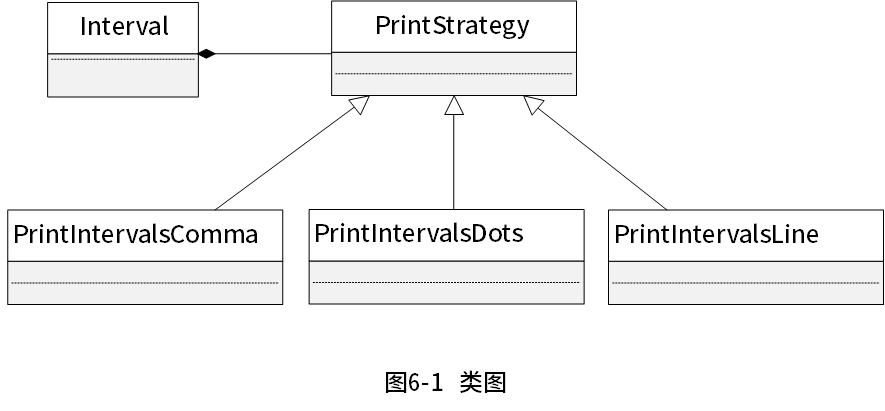阅读下列说明和C++代码,将应填入 (n) 处的字句写在答题纸的对应栏内。
【说明】
在某系统中,类Interval代表由下界(lower bound)和上界 (upper bound) 定义的区间,要求采用不同的格式显示区间范围,如[lower bound,upper bound]、[lower bound...upper bound]、[lower bound - upper bound]等。现采用策略 (Strategy) 模式实现该要求,得到如图6-1所示的类图。

【c++代码】
#include <iostream>
using namespace std;
class Interval;
class PrintStrategy {
public:
(1) ;
};
class Interval {
private:
double lowerBound;
double upperBound;
public:
Interval(double p_lower, double p_upper) {
lowerBound = p_lower;
upperBound = p_upper;
}
void printInterval(PrintStrategy*ptr){
(2) ;
}
double getLower() { return lowerBound; }
double getUpper() { return upperBound; }
};
class PrintIntervalsComma : public PrintStrategy {
public:
void doPrint(Interval *val) {
cout << "[" << val->getLower() << "," << val->getUpper() << "]" << endl; }
};
class PrintIntervalsDots : public PrintStrategy {
public:
void doPrint(Interval *val) {
cout << "[" << val->getLower() << "..." << val->getUpper() << "]" << endl; }
};
class PrintIntervalsLine:public PrintStrategy {
public:
void doPrint(Interval *val) {
cout << "[" << val->getLower() << "-" << val->getUpper() << "]" << endl; }
};
enum TYPE {COMMA, DOTS, LINE};
PrintStrategy* getStrategy(int type) {
PrintStrategy* st;
switch(type){
case COMMA:
(3) ;
break;
case DOTS:
(4) ;
break;
case LINE:
(5) ;
break;
}
return st;
}
int main() {
Interval a(1.7,2.1);
a.printInterval(getStrategy(COMMA));
a.printInterval(getStrategy(DOTS));
a.printInterval(getStrategy(LINE));
return 0;
}